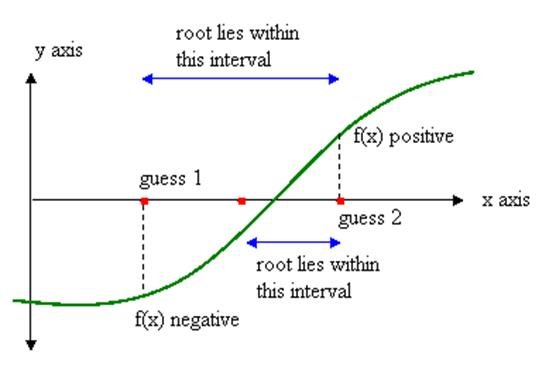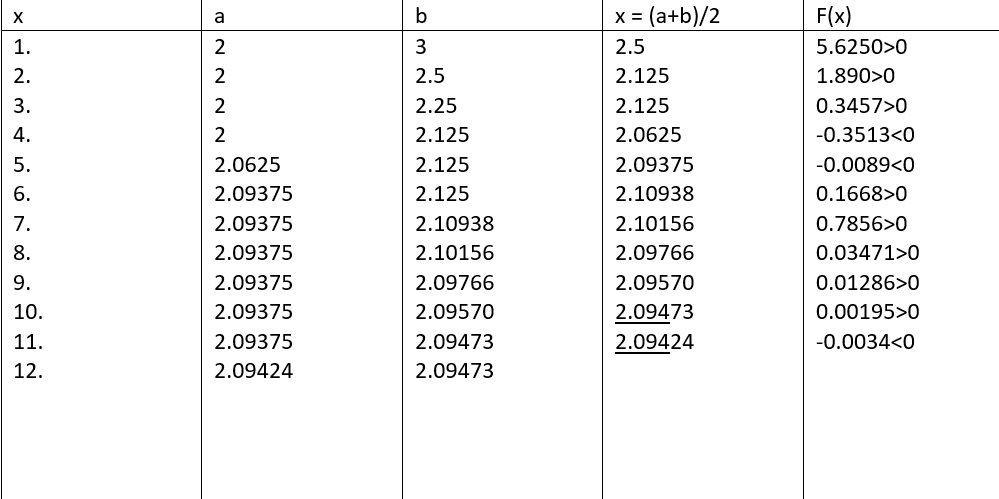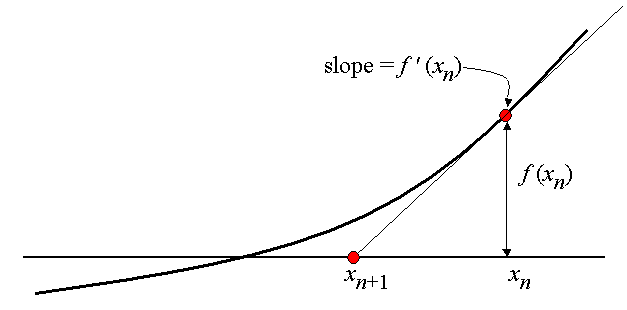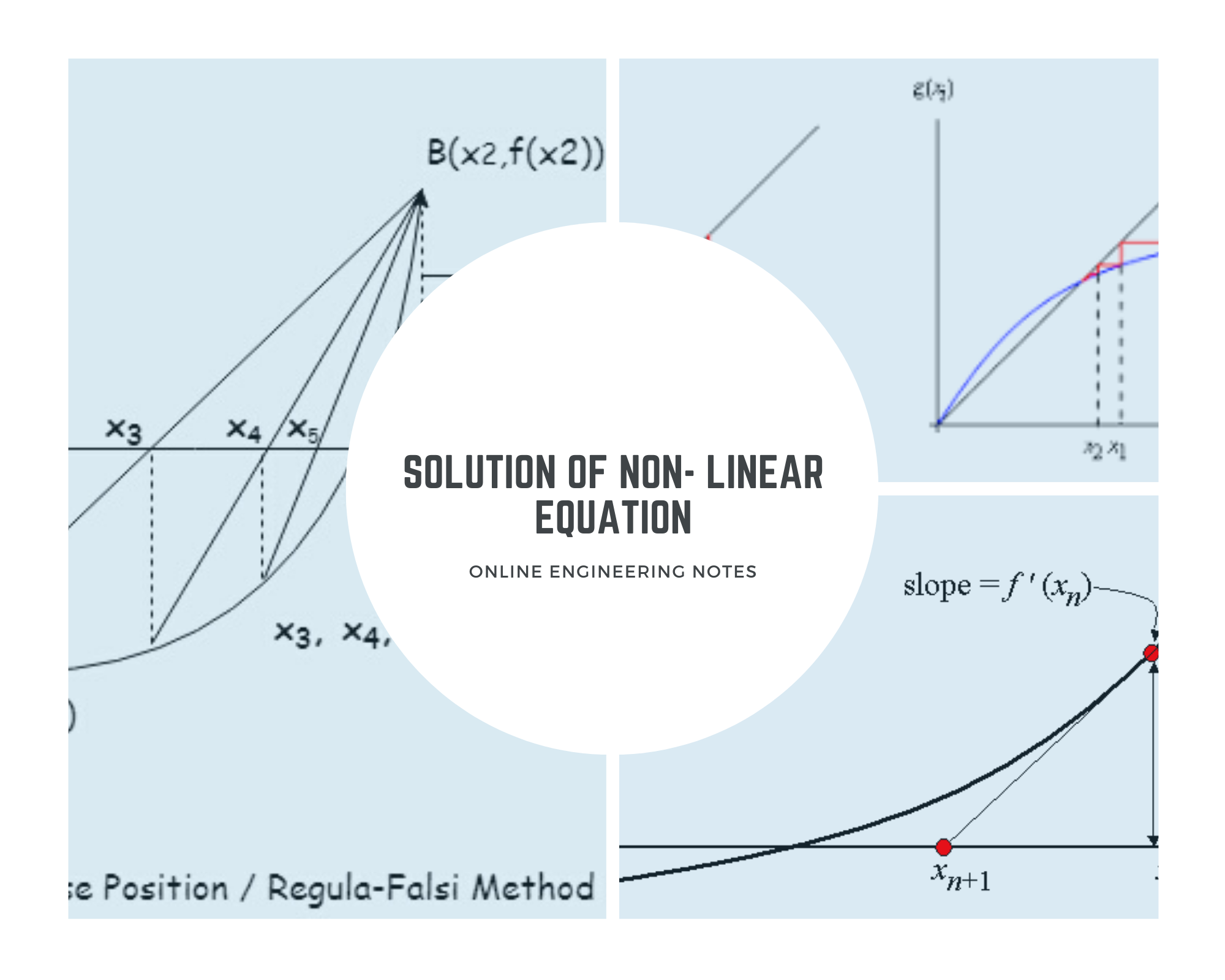Bisection Method:
This method is based on the repeated application of intermediate value property. Let, F(x) be continuous between a and b.
Consider,
F(a) be negative and F(b) be positive.
Then, the first approximation of the root is x1= (a+b)/2 , if F(x1)= 0 then x1 is root of F(x)=0.
Otherwise, the root lies between a and x1 or x1 and b, according as F(x1) is positive or negative.
Then, we bisect the interval as before and continue the process until the root is found accuracy.

Problem: (By Bisection Method)
QNo.1 Find the real roots of the equation x3-2x-5=0
Solution:
Given,
Let,
F(x) = x3-2x-5
F(0) = -5
F(1) = -6
F(2) = -1
F(3) = 16
Also,
x1 = (a+b)/2
or, x1 = (2+3)/2 = 2.5
F(2.5) = (2.5)3 – 2*2.5-5 = 5.6250

Hence, the real root of the equation is 2.094.
False Position Method (Regula-Falsi Method)

Slope of AB = Slope of AC
Or, {F(b)-F(a) }/(b-a) = {0-F(a)}/(c-a)
Or, c-a = {-F(a) * (b-a)} / { F(b) – F(a)}
Or, c = a – {F(a) * (b-a)} / { F(b) – F(a)}
∴ c = {a *F(a) – bF(a) } / {F(b) – F(a)}
Working Procedure (Method):-
1. Find the interval (a,b)
Straight F(a) F(b) <0
2. Find c = {a* F(a) – bF(a) } / {F(b) – F(a)}
3. F(a) F(c) <0 roots lies in (a,c) & F(b) F(c)<0 roots lies in (c,b)
4. Repeat step (1.) and (2.)
Problem: ( By False Position Method)
Qno.1 Find a real root of x3-2x-5=0 using the method false position upto four iteration.
Solution:
Let, F(x) = x3-2x-5
F(2) = -1
F(3) = 16
Now,
I- interation
a=2, F(a)= -1
b=3,F(b)= 16
Using the formula, we get
c = {a* F(a) – bF(a) } / {F(b) – F(a)}
or, c= (32+3)/(16+1) = 2.0588
F(c)= F(2.0588)= -0.3908<0
II-interation
a= 2.0588, F(a) = -0.3908
b= 3, F(b) = 16
c = {a* F(a) – bF(a) } / {F(b) – F(a)}
or, c= {16(2.0588)+3(0.3908)}/(16+0.3908) = 2.0812
F(c) = F(2.0812) = -0.1479
III-interation
a=2.0812, F(a) = -0.1479
b= 3 , F(b) = 16
c = {a* F(a) – bF(a) } / {F(b) – F(a)}
or, c = {16(2.08120)+3(0.1479)}/(16+0.1479)= 2.0896
F(c)=F(2.0896)=-0.0551<0
IV-interation
a=2.0896, F(a) = -0.0551
b= 3 , F(b) = 16
c = {a* F(a) – bF(a) } / {F(b) – F(a)}
or, c = {16(2.0896)+3(0.0551)}/(16+0.0551)= 2.0927
Hence, the required root is = 2.0927.
Fixed Point Iteration Method (Iteration Method)

Suppose we have equation F(x) = 0. The equation can be expressed as x = ϕ(x)
At x= x0
|ϕ| (x) |< 1
Then, iterative method applied. The suceesive approximation is
Given by xn= ϕ(xn-1)
x1= ϕ(x0)
x2= ϕ(x1)
Now,
xn = 1 / (1+ xn-1)1/2
Problem: (By Fixed Point Iteration Method)
Qno1. Find the roots of cosx = 3x -1, correct to four decimal places by iteration method.
Solution:
Let,
F(x) = cosx – 3x+1
F(0)= 2
F( π/2) = 0 – (3 π/2)+ 1 < 0
Now,
x = ϕ(x) —————————-(i)
So, taking equation
Cosx = 3x-1
Or, 3x = 1 + cosx
Or, x = (1+ cosx)/3
Now,
Equation (i) is
ϕ(x) = (1+ cosx)/3
Differentiating on both side w.r.t x
|ϕ| (x) | = |sinx/3 |
At x0 = 0
|ϕ| (x) | = |sin0/3 | <1
Or, |ϕ| (x) | = 0 <1
Now,we can apply equation
x= (1+cosx)/3
Now,
xn = (1+ cos xn-1)/3
Put, n=1
x1 = (1+cos x0)/3 = 0.066667
Put, n = 2
x2 = (1+ cos (0.066667) * 57.3)/3 = 0.595296
x3 = (1+cos(0.595296)* 57.3)/3 = 0.609328
x4 = (1+cos(0.609328)* 57.3)/3 = 0.606678
x5 = (1+cos(0.606678)* 57.3)/3 = 0.60782
x6 = (1+cos(0.60782)* 57.3)/3 = 0.607086
x7 = (1+cos(0.607086)* 57.3)/3 = 0.607105
x8 = (1+cos(0.607105)* 57.3)/3 = 0.607101
The correct root to four decimal places is 0.6071.
Secant Method ( Chord Method)

This method is quite similar to false position method except for the condition F(x1) F(x2) < 0.
Slope of AB = Slope of AC
Or, x-x0 = – {F(x0)(x1-x0)}/{ F(x1) – F(x0)}
Or, x = {x0F(x1) – x1F(x0)}/ { F(x1) – F(x0)}
Now,
xn+2 = {xnF(xn+1) – xn+1F(xn)}/{F(xn+1) – F(xn)}
This method fails when F(xn) = F(xn+1).
Problem:( By Secant Method)
Qno.1. Estimate the root of the equation cosx-xex= 0 . Using the secant method with initial estimate of x1 = 0.5 , x2=1.
Solution:
F(x) = cosx – xex
F(x1)=F(0.5)= cos(0.5) – (0.5) e(0.5) = 0.0532
F(x2)=F(1)= cos(1) – (1) e(1) = -2.17798
xn+1 = {xn=1 F(xn) – xnF(xn-1)}/ {F(xn)- F(xn-1)}
Put, n=2
x3 = {x1F(x2)-x2F(x1)} / {F(x2) – F(x1)} = 0.5119
F(x3) = F(0.5119)= cos(0.5119) – (0.5119) e(0.5119) = 0.01773
Put, n=3
x4 = { x2F(x3)-x3F(x2)} / {F(x3) – F(x2)} = 0.5158
F(x4) = F(0.5158)= cos(0.5158) – (0.5158) e(0.5158) = 0.00544
Put, n=4
x5 = { x3F(x4)-x4F(x3)} / {F(x4) – F(x3)} = 0.5178
F(x5) = F(0.5178)= cos(0.5178) – (0.5178) e(0.5178) = 0.00012
Put, n=5
x6 = { x4F(x5)-x5F(x4)} / {F(x5) – F(x4)} = 0.5178
F(x5) = F(0.5178)= cos(0.5178) – (0.5178) e(0.5178) = 0.00012
Hence, the root of the equation is 0.5178.
Newton Raphson Method

Equation of Tangent
y-F(x0) = F’(x0) (x1-x0)
or, 0-F(x0) = F’(x0) (x1-x0)
or, x1-x0= -F(x0) / F’(x0)
or, x1 = x0 -F(x0) / F’(x0)
Now,
xn+1 = xn -F(xn) / F’(xn) , F’(xn) ≠ 0
Problem: ( By Newton Raphson Method)
Qno1. Find by Newton Raphson Method a root of equation x3-3x- 5 = 0.
Solution:
F(x)= x3-3x- 5
F(2)= -3
F(3)= 16
Now,
F’(x) = 3 x2– 3
Using Formula,
xn+1 = xn -F(xn) / F’(xn)
or, xn+1 = xn – (xn3-3 xn – 5)/(3 xn 2– 3)
Put, n=0
x1 = x0 – (x03-3 x0 – 5)/(3 x0 2– 3) = 2.3333
Put, n=1
x2 = x1 – (x13-3 x1 – 5)/(3 x1 2– 3) = 2.2805
Put, n=2
x3 = x2 – (x23-3 x2 – 5)/(3 x2 2– 3) = 2.2790
Put, n=3
x4 = x3 – (x33-3 x3 – 5)/(3 x3 2– 3) = 2.2790
Hence, the required root is 2.2790.
Reference 1 : Numerical Methods , Dr. V.N. Vedamurthy & Dr. N. Ch. S. N. Iyengar, Vikas Publishing House.

